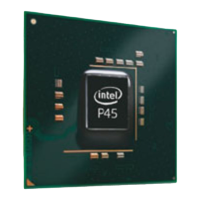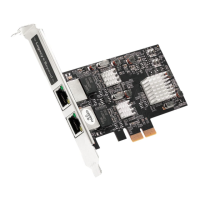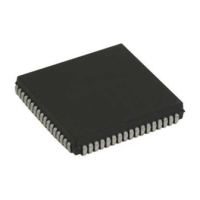Introduction
7 Thermal and Mechanical Design Guidelines
1 Introduction
As the complexity of computer systems increases, so do power dissipation
requirements. The additional power of next generation systems must be properly
dissipated. Heat can be dissipated using improved system cooling, selective use of
ducting, and/or passive heatsinks.
The objective of thermal management is to ensure that the temperatures of all
components in a system are maintained within functional limits. The functional
temperature limit is the range within which the electrical circuits can be expected to
meet specified performance requirements. Operation outside the functional limit can
degrade system performance, cause logic errors, or cause component and/or system
damage. Temperatures exceeding the maximum operating limits may result in
irreversible changes in the operating characteristics of the component.
This document is for the following devices:
• Intel
®
P45 Chipset MCH (82P45 MCH)
• Intel
®
P43 Chipset MCH (82P43 MCH)
• Intel
®
G45 Chipset GMCH (82G45 GMCH)
• Intel
®
G43 Chipset GMCH (82G43 GMCH)
• Intel
®
G41 Chipset GMCH (82G41 GMCH)
• Intel
®
Q45 Chipset GMCH (82Q45 GMCH)
• Intel
®
Q43 Chipset GMCH (82Q43 GMCH)
This document presents the conditions and requirements to properly design a cooling
solution for systems that implement the (G)MCH. Properly designed solutions provide
adequate cooling to maintain the (G)MCH case temperature at or below thermal
specifications. This is accomplished by providing a low local-ambient temperature,
ensuring adequate local airflow, and minimizing the case to local-ambient thermal
resistance. By maintaining the (G)MCH case temperature at or below those
recommended in this document, a system designer can ensure the proper
functionality, performance, and reliability of this component.
Note: Unless otherwise specified the information in this document applies to all
configurations of Intel
®
P45, P43, Q45, Q43, G45, G43, and G41 Chipsets. The Intel
®
Q45, Q43, G45, G43, and G41 Chipsets are available with integrated graphics and
associated SDVO and digital display ports. In this document the integrated graphics
version is referred to as GMCH. In addition a version will be offered using discrete
graphics and is referred to as the MCH. The term (G)MCH will be used to when
referring to all configurations.
Note: In this document the Intel P45, P43, Q45, Q43, G45, and G43 Chipsets refer to the
combination of the (G)MCH and the Intel
®
ICH10. For ICH10 thermal details, refer to
the Intel
®
I/O Controller Hub 10 (ICH10) Thermal Design Guidelines. The Intel G41
Chipset refers to the combination of the GMCH and Intel ICH7. For ICH7 details, refer
to the Intel
®
I/O Controller Hub 7 (ICH7) Thermal Design Guidelines.

